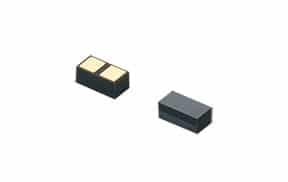source: Murata news
Murata commercialized the “Micro-heater” – the world’s smallest class (1.6 × 0.8× 0.68 mm) of ultra-miniature ceramic heater used as a PTC thermistor for a heater, and commenced mass production in November 2016. This product is to be exhibited at Murata’s booth at “Medtec Japan 2017,” which is scheduled to commence on April 19.
Background
Along with the heightened interest in health care, and the increasing diversification of health appliances and electrical beauty appliances, components used for a heater function are required to have a high degree of mounting freedom and also the ability to effectively heat the necessary location. In order to meet these needs of the market, Murata developed the “Micro-heater” ultra-miniature chip ceramic heater of size 1.6 × 0.8× 0.68 mm, which consists of a heater PTC thermistor encapsulated in insulating resin.
Because this device is small, it has high heat response. Also, because the flat top surface, which has high electrical insulation, is placed into intimate contact with the mounting surface, it is possible to directly and efficiently heat the necessary location. In addition, if multiple devices are arranged side by side, it is possible to create heaters of various shapes, and also contribute to greater freedom of design.
Because this device generates heat using only a low voltage, electric power can be used without waste. This energy-saving design also enables the device to be powered by a dry battery (1.5 VDC). Also, because of the self-temperature control function possessed by PTC ceramic material, the temperature does not rise significantly higher than that near the Curie point, so it can be said that this device is simple and also very safe.
Application
- Health care and health appliances
- Beauty appliances
- General electronic appliances
- Temperature compensating circuit employing heating
Features
- Ultra-miniature: 1608 size
- High temperature response
- Has a high degree of mounting freedom, and efficiently heats the target location.
- Wastes little electric power, and can also be powered by a dry battery (1.5 VDC).
- High degree of safety due to the self-temperature-control function of PTC ceramics.
Electric characteristic
| Item | Specification |
|---|---|
| Resistance at 25℃ | 2.2 – 68 ohm (7 types) |
| Curie point | 85 – 105 °C |
| Max voltage | 2 – 6 V |
| External size | 1.6 × 0.8 × 0.68mm |
External size:1.6×0.8×0.68mm
































